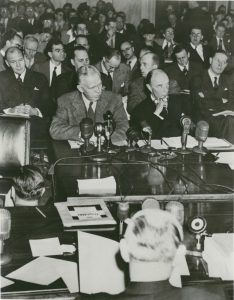Seventy years ago this week the Senate Foreign Relations Committee (SFRC) continued to work on approving the details of the European Recovery Program. The European Recovery Program, or ERP, was more commonly known as the Marshall Plan. Opposition in Congress, which reflected public sentiment, was widespread. Some thought Europe needed to solve its own problems or that the plan should be administered by the United Nations. Others felt the ERP was another “New Deal” that the government should not fund or that aid to China should be prioritized.
 State Department staff, cabinet members and a total of ninety-five witnesses prepared their presentations to Congress. Secretary of State George C. Marshall began the hearings, speaking without notes, stating, “The United States has expended vast resources in the quest for peace. If by the expenditure of an additional amount, small in proportion to the investment made, we can finish the job…To be effective, our action should meet four tests. It must be prompt. It must be adequate in amount. It must be efficient and flexible in operation. It must be cooperative in relation to other participating countries.”
State Department staff, cabinet members and a total of ninety-five witnesses prepared their presentations to Congress. Secretary of State George C. Marshall began the hearings, speaking without notes, stating, “The United States has expended vast resources in the quest for peace. If by the expenditure of an additional amount, small in proportion to the investment made, we can finish the job…To be effective, our action should meet four tests. It must be prompt. It must be adequate in amount. It must be efficient and flexible in operation. It must be cooperative in relation to other participating countries.”
Many were convinced of the purpose of the recovery plan, but major opposition about administration of the program and its funding remained. The SFRC agreed to have an independent director for the ERP and approved a plan to administer the program outside the State Department, adopting a plan from the Brookings Institute (a plan requested by Senator Arthur Vandenberg), which followed the administrative model of the newly formed Atomic Energy Commission. The independent organization, which would become the Economic Cooperation Administration (ECA), would be controlled by civilians and not the federal government. A twelve-person advisory board of private citizens would supervise how Marshall Plan funds were used. The veto power of the Secretary of State over the ERP both at policy and working levels was also removed. The independent administrator and the Secretary of State would keep each other informed, and if the Secretary of State believed any action was inconsistent with U.S. foreign policy objectives, he would consult with the administrator. If it was not resolved, the matter would be referred to the President. The SFRC also resolved that the United States would send a special ERP mission to each participating country and the head would rank as minister and be considered second to the ambassador.
On Friday, February 13, 1948, the SFRC approved the policy for the four-year European Recovery Program unanimously (the appropriations battle came next). The SFRC did not include specific conditions for the countries but would review how they were living up to their commitments each year. The committee added a clause cutting off aid to any nation “out of step” with the program or falling to communism.
That night, after being grounded by bad weather on his way to speaking to the National Farm Institute’s Annual Meeting, Secretary of State Marshall instead gave a radio address from Knoxville, Tennessee. Of the ERP, he said, “If adopted, it will rank, I think, as one of the great historic undertakings in the annals of world civilization.” Concluding his eight-minute speech, Marshall said, “I know all of you are proud to be Americans. I am sure most of you think this country of ours is the greatest, the most powerful in the world, that we lead the way to better things for the working people, the common people, all the people. Now, if that is so we have a great responsibility, for you cannot be a leader without leading, and the more distressing or dangerous the situation, the more necessary, it is for a leader to take action. That is what I am asking of this country today.”
To learn more about the Marshall Plan and why its success has never been replicated, please visit the Marshall Legacy Series exhibit “Hope for Those Who Need It” in the Marshall Museum’s lower gallery.
